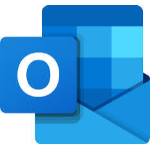TechnologyCounter provides genuine, unbiased real user reviews to help buyers make informed decisions. We may earn a referral fee when you purchase through our links, at no extra cost to you.
List of 15 Best Email Collaboration Tools
Showing 1 - 15 of 22 productsMicrosoft Outlook is a tool for effective email management. With its user-friendly interface and a wide range of features, this powerful software is designed to streamline your communication and enhance your productivity. From emails to calendars, co...Read Microsoft Outlook Reviews
Zoho Mail is a clean, ad-free email provider that lets you increase your emailing efficiency with a feature-rich experience. Collaboration, ease of use, and a strong stance on privacy are at the heart of Zoho Mail. Feel the freedom with nimble mobile...Read Zoho Mail Reviews
Chamaileon is a email design and collaboration platform for marketers and designers. With its user-friendly interface and powerful features, Chamaileon helps streamline the email design process and boost productivity. Say goodbye to generic, tedious...Read Chamaileon Reviews
Kopano is a and innovative software that is revolutionizing the way teams collaborate and communicate. With its user-friendly interface features, Kopano streamlines workflows and increases productivity. Join the thousands of satisfied users and exper...Read Kopano Reviews
Gmelius is a email and project management tool designed to streamline your daily workflow. With its user-friendly interface and robust features, Gmelius helps you stay organized, collaborate seamlessly with your team, and boost productivity. Say good...Read Gmelius Reviews
Hiver is a tool that revolutionizes communication and collaboration for teams. With its simple yet dynamic interface, Hiver allows for seamless teamwork is a management of tasks. Say goodbye to the chaos of email chains and hello to a streamlined wor...Read Hiver Reviews
Stripo is a email design and marketing software that empowers businesses and individuals to effortlessly create impactful email campaigns. With its user-friendly interface features, Stripo makes email designing a breeze. Say hello to professional-loo...Read Stripo Reviews
Kayako is a customer service software that streamlines communication and enhances customer relationships. With its user-friendly interface and robust features, Kayako helps businesses provide exceptional support and resolve customer issues efficientl...Read Kayako Reviews
Drag is a software that simplifies team collaboration and project management. Designed to streamline your workflow, Drag allows you to organize, delegate, and track tasks directly from your inbox. With its user-friendly interface is a features, Drag...Read Drag Reviews
Missive is a all-in-one communication tool that streamlines your teams conversations and tasks in one convenient platform. Say goodbye to cluttered emails and endless switching between different apps. With Missive, collaboration has never been easier...Read Missive Reviews
Help Scout is a customer support solution for businesses of all sizes. With its user-friendly interface and powerful features, Help Scout streamlines communication, improves collaboration, and enhances the overall customer experience. Say goodbye to...Read Help Scout Reviews
Trengo is a communication tool for businesses of all sizes. With its seamless integration of messaging channels, efficient team collaboration, features, Trengo revolutionizes the way organizations connect with customers and manage their communication...Read Trengo Reviews
Mayple is a platform connecting businesses with expert marketing professionals. By matching the right expert to each project, Mayple ensures top-quality results and measurable success. With a focus on collaboration and transparency, Mayple empowers b...Read Mayple Reviews
Omnisend is a email and marketing automation platform designed to help businesses of all sizes connect with and engage their customers more effectively. With a user-friendly interface features, Omnisend provides a seamless is a solution for creating...Read Omnisend Reviews
Inbox Pirates, is a solution for managing and organizing your email inbox like never before. Say goodbye to cluttered and overwhelming inboxes with our innovative software designed to streamline your email communication and boost your productivity. G...Read Inbox Pirates Reviews
- What Is Email Collaboration Tools?
- Top Reasons Why Businesses Need Email Collaboration Tools?
- What Are the Top Key Features of Email Collaboration Tools?
- What Are the Top Benefits of Email Collaboration Tools?
- What Are the Steps to Choose the Right Email Collaboration Tools?
- What Are the Types of Email Collaboration Tools for Different Industries?
- What Are the Technology Trends for Best Email Collaboration Tools?
- What Are the Deployment Options for Email Collaboration Tools?
What Is Email Collaboration Tools?
Email collaboration tools refer to software applications that facilitate the collective management of emails, contacts, and shared digital documents by several users. These solutions operate through a cohesive, cloud-based interface.
The objective of email collaboration software is to enhance the efficiency and organization of managing email correspondences, projects, and contacts. The best email collaboration tools frequently encompass functionalities such as an electronic mail client, task management system, and calendar application.
The email client serves as a tool for the creation, transmission, and organization of electronic mail messages. The task manager facilitates the monitoring of projects, deadlines, and the delegation of duties to other users. An instance of task delegation can be observed when a manager utilizes the technology to send an email notification to a colleague, thereby assigning a certain work.
The calendar function serves as a useful means of managing and organizing various time-sensitive commitments, such as deadlines, meetings, and appointments. The utilization of email collaboration software facilitates the exchange of digital content.
The consolidation of essential project materials in a single location enables users to conveniently access them, fostering enhanced communication among diverse team members. Businesses frequently utilize this particular software to facilitate the accessibility of shared information across team members.
Email collaboration tools serve as effective means to streamline the digital workflow within a business. The utilization of these tools facilitates enhanced communication, cooperation, and organization among members of a team.
This phenomenon has the potential to result in heightened levels of efficiency and productivity, as it enables the more efficient management of tasks.
Top Reasons Why Businesses Need Email Collaboration Tools?
1. The purpose of this platform is to facilitate collaboration among individuals working on various projects and responsibilities.
2. In order to facilitate the consolidation of document storage.
3. In order to facilitate the exchange of data with pertinent stakeholders, it is imperative to establish mechanisms that promote effective collaboration and information dissemination.
4. In order to streamline the process of organizing meetings, conference calls, and events,
5. In order to enhance staff communication In order to mitigate the need for human data entry and minimize instances of data duplication,
6. In order to maintain current knowledge among all team members, it is imperative to guarantee that regular updates are provided.
7. In order to facilitate remote access to files
8. In order to effectively monitor and allocate tasks, it is necessary to maintain a record of tasks and assign action items.
9. In order to guarantee adherence to records preservation rules in accordance with legal requirements,
10. In order to facilitate more efficient communication among team members, a streamlined method for tracking and revisiting conversations is being implemented.
11. In order to optimize efficiency and reduce financial costs associated with travel expenditures,
12. In order to enhance productivity and foster effective collaboration among team members, it is imperative to implement strategies and initiatives.
13. In order to avail oneself of a range of functionalities, including security configurations and the ability to store messages for future reference.
14. In order to safeguard electronic mail communications, it is imperative to implement robust procedures aimed at mitigating the risks posed by spam and viruses.
What Are the Top Key Features of Email Collaboration Tools?
1. Automated Email Tracking: Automated email tracking solutions provide customers with the capability to access and monitor many aspects of their emails, including viewing the content of emails, tracking subsequent follow-up messages, monitoring link activity, and obtaining information on the delivery status of emails sent to recipients.
2. Shared Calendars and Social Collaboration: Collaborative email technologies facilitate the sharing of calendar availability and real-time connection with colleagues, thereby fostering an elevated level of collaboration.
3. Document Management: Individuals have the ability to store many types of files, including PDFs, Word documents, images, and spreadsheets, within a shared workspace.
4. Group Chats: Group chats facilitate communication among users without the need for email correspondence.
5. Meeting Scheduling: The functionality of meeting scheduling facilitates the efficient organization of meetings involving one or several individuals concurrently.
6. Automated Workflow Creation: Automated workflow creation tools facilitate the construction and administration of automated processes by leveraging pre-existing workflow templates.
7. Shared Contact Lists: Shared contact lists enable users to effectively handle contacts across a team and conveniently include new contacts.
8. Data Reports: Data reports provide consumers with the ability to analyze the performance of their emails and detect any concerns.
9. Email Filtering and Security Measures: Email screening and security protocols are implemented to safeguard users against the infiltration of harmful emails and various forms of cyber threats.
10. Third-Party Integrations: Third-party connectors provide users the opportunity to avail themselves of a diverse array of business apps.
What Are the Top Benefits of Email Collaboration Tools?
1. Increased Efficiency: Email collaboration tools offer a structured platform for the creation and storage of emails, hence enhancing the efficiency of communication workflows and expediting collaborative efforts.
2. Improved Communication: Email collaboration software facilitate enhanced communication and coordination among different users within a company, hence improving overall efficiency and productivity.
3. Increased Productivity: The optimization of time allocation towards manual email-related chores enables employees to enhance their productivity by devoting greater attention to their primary job obligations.
4. Automated Collaboration: The utilization of email templates and automated processes enables individuals to automate their collaborative efforts and optimize their communication workflows.
5. Cost Savings: The utilization of an email collaboration software results in a reduction in both paper consumption and labor hours that are typically expended in the manual creation and archival of emails.
6. Improved Security: Email collaboration systems frequently incorporate inherent security mechanisms, including encryption, authentication, and approval processes, in order to safeguard sensitive and secret data.
7. Improved Compliance: Email collaboration systems frequently provide auditing capabilities, hence facilitating organizational compliance with industry rules and established protocols.
What Are the Steps to Choose the Right Email Collaboration Tools?
1. Determine the requirements and objectives of your organization. Consider the specific industry within which your organization operates, the magnitude of individuals who will utilize the tool, and the nature of communication that is intended to be facilitated.
2. Conduct a comprehensive investigation of currently available prominent tools in order to ascertain the range of functions they provide. Conduct a comparative analysis of many alternatives and ascertain which ones are most suitable for fulfilling your requirements.
3. Email collaboration software is imperative to take into account the financial implications associated with the acquisition of the instrument. It is imperative to ensure that the expenses are kept within the allocated budget while still offering the necessary functionalities.
4. Evaluate the level of user-friendliness. It is essential to assess the level of intuitiveness and user-friendliness of the product prior to making a definitive choice.
5. The deployment and installation of a system should be carefully considered. Prior to implementing the technology on a broader scale, it is advisable to gather user input from a small group.
6. Conduct a comprehensive evaluation of the instrument to ascertain its compliance with the established criteria of your firm. Best email collaboration tools is imperative to conduct a thorough analysis of the test outcomes in order to ascertain whether the tool aligns with the established criteria.
7. Continuously assess and evaluate feedback following the deployment phase. Ensure that you make necessary modifications in accordance with the feedback received from users in order to ascertain the appropriateness of the selected tool for your firm.
What Are the Types of Email Collaboration Tools for Different Industries?
There are a variety of email collaboration tools that can benefit different industries. Below is a list of some of the most popular tools available:
1. Project and Task Management Software: These software applications facilitate project and task management, enabling teams to establish deadlines and objectives. Some examples of task management tools are Asana, Podio, and Trello.
2. Document Collaboration Tools: These collaborative solutions facilitate real-time collaboration across teams on various types of documents, including those related to sales, marketing, and other domains. Some examples of such tools include Google Docs and Dropbox Paper.
3. Shared Calendars: Shared calendars facilitate effective collaboration across teams by providing a platform for tracking significant dates and events, hence enabling the scheduling of meetings and conferences. Some examples of calendar applications are Google Calendar and Microsoft Exchange.
4. CRM Tools: These tools are utilized for the purpose of managing client connections, monitoring and managing potential customers, and successfully finalizing business transactions. Some examples of customer relationship management (CRM) software solutions are Salesforce and Zoho CRM.
5. VOIP and Instant Messaging Platforms: These tools facilitate efficient and convenient team communication, encompassing both spoken and written exchanges, and can be effectively employed for customer support, sales, and several other purposes.
Two examples of communication and collaboration platforms are Microsoft Teams and Slack. Each of these tools possesses the potential to enhance collaboration throughout diverse industries, contingent upon the unique requirements of each business.
What Are the Technology Trends for Best Email Collaboration Tools?
In the contemporary landscape of fiercely competitive business environments, the imperative for efficient email communication solutions has emerged as a paramount concern for organizations across various scales.
A variety of emerging technologies and solutions have been developed to enhance communication and cooperation within the context of email.
This document provides a comprehensive analysis of the leading technological advancements in the realm of email collaboration tools.
1. Hybrid cloud systems: Hybrid cloud solutions enable enterprises to effectively utilize the economic advantages and scalability offered by cloud systems, while simultaneously maintaining authority over security measures and data governance standards.
The adoption of hybrid cloud systems is on the rise among enterprises, primarily driven by their inherent flexibility and scalability, which enables them to effectively adapt to evolving business requirements.
2. Automation and artificial intelligence: Artificial intelligence (AI) is currently being employed to automate specific email-related functions, including the management of customer questions and the categorization of incoming messages.
Artificial intelligence (AI) plays a crucial role in the automation of monotonous chores, including the classification of emails, the allocation of emails to various team members, and the identification of emails requiring subsequent actions. Automation has a pivotal role in enhancing production, mitigating human errors, and yielding outcomes of higher precision.
3. Multi-Device Support: The utilization of mobile devices, such as tablets and smartphones, is experiencing a notable surge in popularity within professional environments, as individuals increasingly depend on these technological tools to accomplish their tasks.
Therefore, email collaboration software is imperative that email collaboration platforms has the capability to facilitate access across several devices, enabling users to conveniently retrieve their accounts from any location. Numerous email collaboration platforms have mobile applications or web applications, enabling users to conveniently access their accounts across various devices.
4. Search functionality: The inclusion of search functionality has become an essential requirement for contemporary best email collaboration tools. This functionality allows users to efficiently locate the desired information within their inbox, regardless of the extent of their search.
5. Security and data protection: Given the widespread utilization of email as a means of communication, ensuring the safeguarding and security of data has paramount importance. Email collaboration platforms should possess the capability to safeguard user data by employing encryption techniques and ensuring secure storage of the data.
What Are the Deployment Options for Email Collaboration Tools?
The deployment choices for email collaboration tools are contingent upon the specific tools employed, the scale of the organization, and the unique requirements of that organization.
Typically, the available choices for deploying best email collaboration tools encompass SaaS (Software as a Service), On-Premise, or Hybrid implementations.
1. Software-as-a-Service (SaaS) deployments are frequently used for email collaboration tools due to their widespread popularity, mostly owing to their cost-effectiveness and minimal hardware and software resource requirements.
Additionally, SaaS installations include lower initial expenses. Software as a Service (SaaS) entails consumers accessing software through a subscription model, wherein they assume responsibility for their user experience and support needs.
2. On-premise deployments tend to incur more costs compared to SaaS deployments, although offer superior control over the user experience due to the organization's ability to tailor the program according to their unique requirements.
In addition, it is vital for the business to furnish the necessary hardware and software resources in order to facilitate the operation of the best email collaboration tools.
3. Hybrid installations enable enterprises to leverage an on-premise solution while maintaining connectivity to cloud-based data.
Large enterprises frequently opt for this solution due to its ability to provide enhanced control over data security and user experience, while simultaneously enabling them to leverage cloud storage and other associated cloud-based services.















